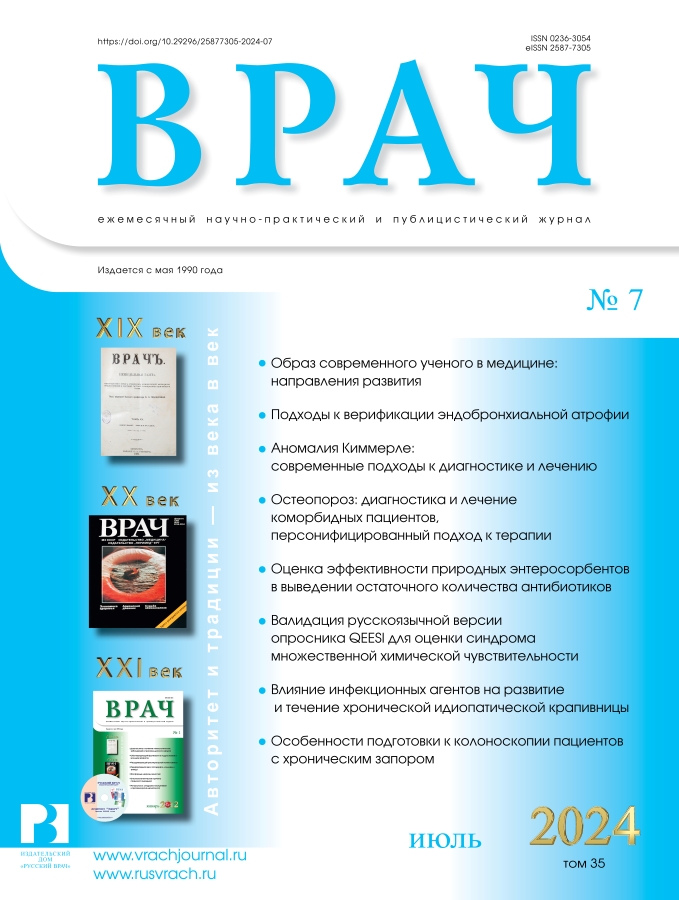Validation of the russian-language version of the QEESI questionnaire for the assessment of multiple chemical sensitivity syndrome
- 作者: Bolotova E.V.1, Dudnikova A.V.2, Onopriev V.V.1, Batrakova L.V.1, Abramenko A.G.2
-
隶属关系:
- Kuban State Medical University, Ministry of Health of Russia
- Clinic of Kuban State Medical University, Ministry of Health of Russia
- 期: 卷 35, 编号 7 (2024)
- 页面: 57-64
- 栏目: From Practice
- URL: https://journals.eco-vector.com/0236-3054/article/view/634653
- DOI: https://doi.org/10.29296/25877305-2024-07-10
- ID: 634653
如何引用文章
详细
Patients with multiple chemical sensitivity (MCS) are an extremely heterogeneous group in terms of the nature and severity of symptoms, the level of sensitivity and the nature of external influences. The QEESI questionnaire is used to evaluate it in foreign practice.
Objective. To validate the Russian-language version of the QEESI questionnaire to assess the MCS syndrome.
Materials and methods. Using the QEESI questionnaire, 468 patients (232 men, average age 34.2±9.3 years and 236 women, average age 42.9±13.8 years) who underwent preventive medical examination were surveyed. Statistical processing was performed using the SPSS statistical software package for Windows, version 10.0.
Results. The proportion of the surveyed whose total score exceeded the threshold of 40 points was 211 (45.1%) people, of whom 98 (46.4%) reached or exceeded the threshold in any two of the three subscales. The questionnaire validation procedure consisted of the following stages: translation, preliminary testing, reliability assessment, and validity assessment. The assessment of the reliability of the questionnaire, performed using the calculation of the α-Kronbach coefficient, showed a high degree of internal consistency: 0.7806 for intolerance to inhaled chemicals, 0.8043 for severity of symptoms and 0.8745 for life effects. The criterion validity of the questionnaire was determined by the Spearman correlation method. In most cases of paired correlation, a statistically significant influence and direct dependence have been established.
Conclusion. The data we obtained showed the reliability and validity of the Russian version of the QEESI questionnaire. This questionnaire can be used to identify MCS in patients presenting non-specific complaints and to assess the dynamics of treatment.
全文:
作者简介
E. Bolotova
Kuban State Medical University, Ministry of Health of Russia
编辑信件的主要联系方式.
Email: bolotowa_e@mail.ru
ORCID iD: 0000-0001-6257-354X
Professor, MD
俄罗斯联邦, KrasnodarA. Dudnikova
Clinic of Kuban State Medical University, Ministry of Health of Russia
Email: bolotowa_e@mail.ru
ORCID iD: 0000-0003-2601-7831
Candidate of Medical Sciences
俄罗斯联邦, KrasnodarV. Onopriev
Kuban State Medical University, Ministry of Health of Russia
Email: bolotowa_e@mail.ru
Professor, MD
俄罗斯联邦, KrasnodarL. Batrakova
Kuban State Medical University, Ministry of Health of Russia
Email: bolotowa_e@mail.ru
俄罗斯联邦, Krasnodar
A. Abramenko
Clinic of Kuban State Medical University, Ministry of Health of Russia
Email: bolotowa_e@mail.ru
俄罗斯联邦, Krasnodar
参考
- Andersson L., Claeson A.-S., Dantoft T.M. et al. Chemosensory perception, symptoms and autonomic responses during chemical exposure in multiple chemical sensitivity. Int Arch Occup Environ Health. 2015; 89: 79–88. doi: 10.1007/s00420-015-1053-y
- Haanes J.V., Nordin S., Hillert L. et al. “Symptoms associated with environmental factors” (SAEF) – Towards a paradigm shift regarding “idiopathic environmental intolerance” and related phenomena. J Psychosom Res. 2020; 131: 109955. doi: 10.1016/j.jpsychores.2020.109955
- Baliatsas C., van Kamp I., Swart W. et al. Noise sensitivity: Symptoms, health status, illness behavior and co-occurring environmental sensitivities. Environ Res. 2016; 150: 8–13. doi: 10.1016/j.envres.2016.05.029
- Karvala K., Sainio M., Palmquist E. et al. Building-Related Environmental Intolerance and Associated Health in the General Population. Int J Environ Res Public Health. 2018; 15: 2047. doi: 10.3390/ijerph15092047
- Hetherington L., Battershill J. Review of evidence for a toxicological mechanism of idiopathic environmental intolerance. Hum Exp Toxicol. 2013; 32: 3–17. doi: 10.1177/0960327112457189
- Schmiedchen K., Driessen S., Oftedal G. Methodological limitations in experimental studies on symptom development in individuals with idiopathic environmental intolerance attributed to electromagnetic fields (IEI-EMF) – A systematic review. Environ Health. 2019; 18: 1–24. doi: 10.1186/s12940-019-0519-x
- Dantoft T.M., Skovbjerg S., Andersson L. et al. Inflammatory Mediator Profiling of n-butanol Exposed Upper Airways in Individuals with Multiple Chemical Sensitivity. PLoS One. 2015; 10: e0143534. doi: 10.1371/journal.pone.0143534
- Ashford N.A. Miller C.S. Appendix C: Environmental Exposure and Sensitivity Inventory: Chemical Application of QEESI for Japanese population. New York: John Wiley and Sons, 1998; р. 371–84.
- Miller C.S., Prihoda T.J. The Environmental Exposure and Sensitivity Inventory (EESI): A standardized approach for measuring chemical intolerances for research and clinical applications. Toxicol Ind Health. 1999; 15: 370–85. doi: 10.1177/074823379901500311
- Damiani G., Alessandrini M., Caccamo D. et al. Italian expert consensus on clinical and therapeutic management of multiple chemical sensitivity (MCS). Int J Environ Res Public Health. 2021; 18: 11294. doi: 10.3390/ijerph182111294
- Hojo S., Kumano H., Yoshino H. et al. Application of Quick Environment Exposure Sensitivity Inventory (QEESI) for Japanese population: study of reliability and validity of the questionnaire. Toxicol Ind Health. 2003; 19 (2-6): 41–9. doi: 10.1191/0748233703th180oa
- Hojo S., Ishikawa S., Kumano H. et al. Clinical characteristics of physician-diagnosed patients with multiple chemical sensitivity in Japan. Int J Hyg Environ Health. 2008; 211 (5-6): 682–9. doi: 10.1016/j.ijheh.2007.09.007
- Skovbjerg S., Berg N.D., Elberling J. et al. Evaluation of the quick environmental exposure and sensitivity inventory in a Danish population. J Environ Public Health. 2012; 2012: 304314. doi: 10.1155/2012/304314
补充文件





